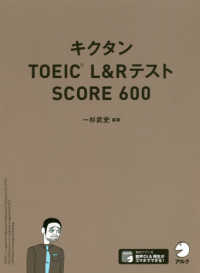- ホーム
- > 洋書
- > 英文書
- > Politics / International Relations
Full Description
How do different electoral systems work to translate votes into seats? What effects do they have on the political system, on political actors, and on voters? Does the choice of electoral system always involve a trade-off between strong and stable government and representation? And do electoral systems matter as much as we might think?
This fully revised and expanded third edition examines the principal types of electoral systems used in over 75 of the world's democracies. It explores why countries choose the electoral systems they do and explains how the different systems function; it investigates the consequences of electoral systems, including on the party system and on government formation and stability, on representation and the quality of democracy, and on parties, politicians, and voters.
Clearly structured, wide-ranging in focus, and incorporating an array of visual material - including authentic ballot papers, tables and figures - this in-depth study remains the go-to text for students and researchers seeking to understand electoral systems around the world.
Contents
1.The Study of Electoral Systems
2.The Single Member Plurality System and its Cousins
3.Majority Electoral Systems: Two-Round Systems and the Alternative Vote
4.The List Systems of Proportional Representation
5.Mixed-Member Electoral Systems
6.The Single Transferable Vote System of Proportional Representation
7.The Systemic Consequences of Electoral Systems
8.The Strategic Consequences of Electoral Systems
9.Electoral System Design and Reform
10.Do Electoral Systems Matter?







